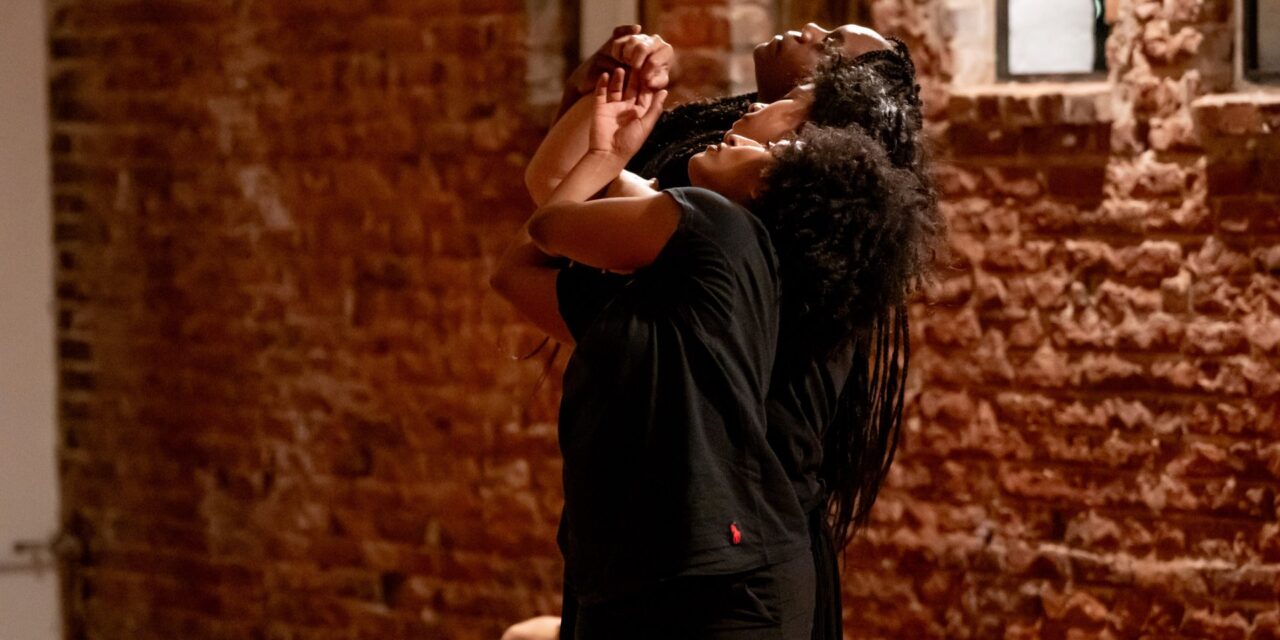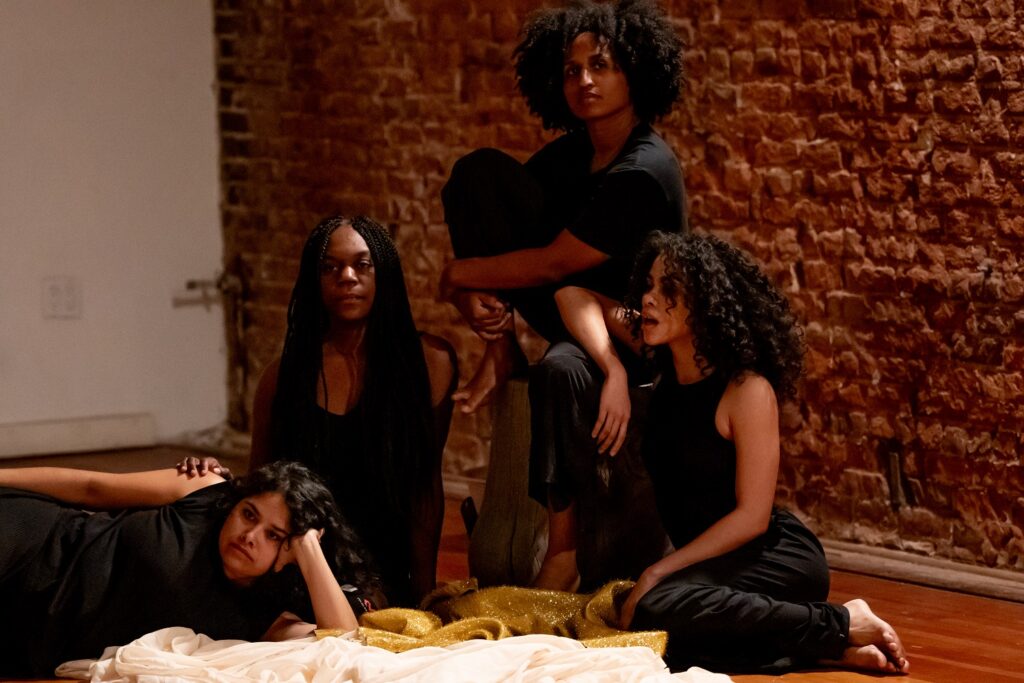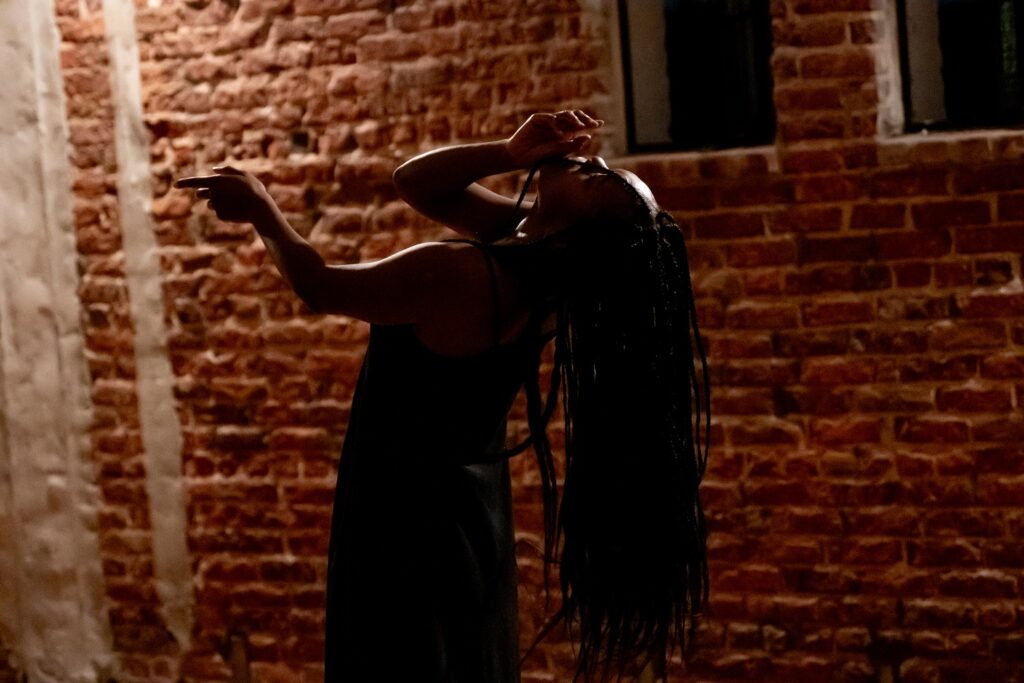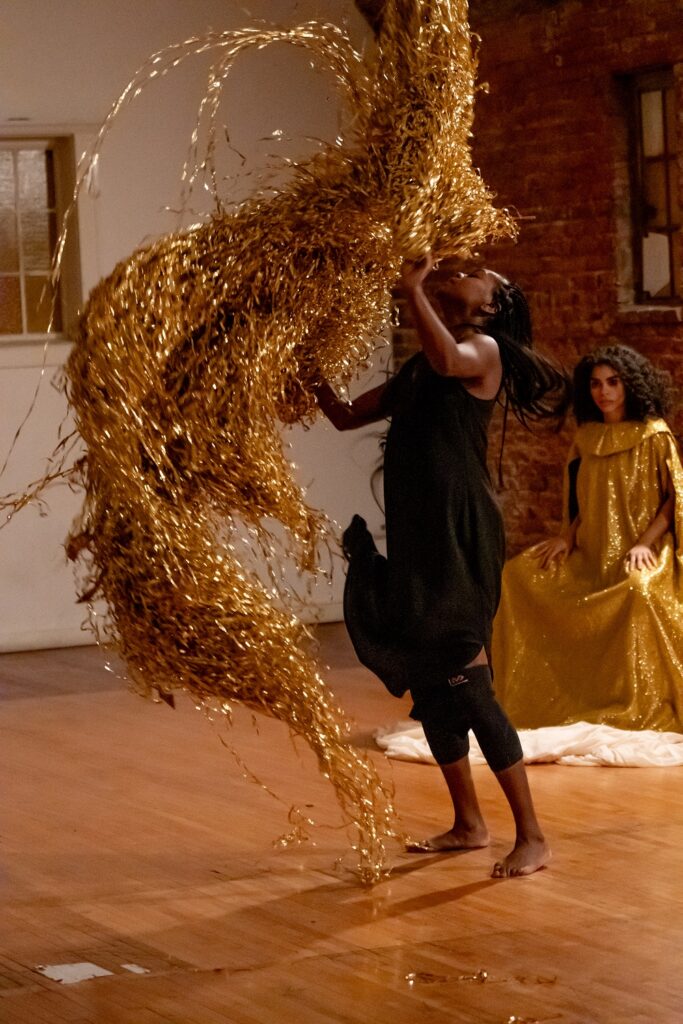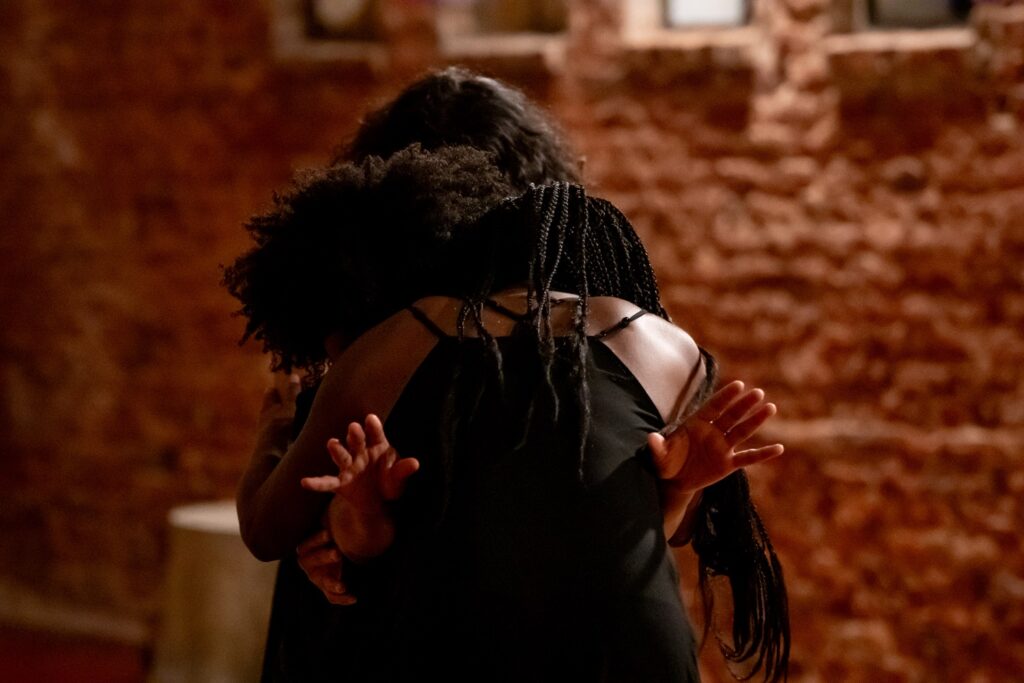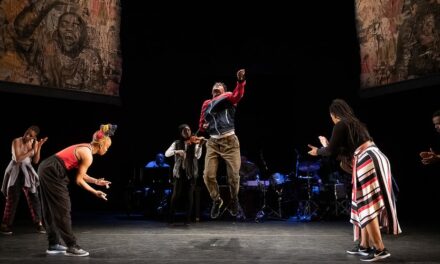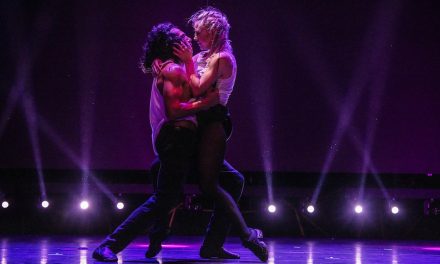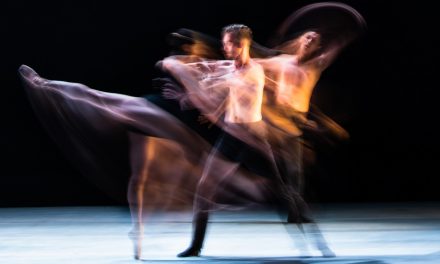In its fifteenth installment, the WIP LA series at G-SON has established itself here in Los Angeles (Chumash, Kizh, and Tongva land) — its small but mighty team plugs away with a rotation of volunteers once a month. We’ve seen what “work-in-progress” can mean, and the way this program meets art in its many stages. For WIP 015, the artists — Suchi Branfman, artistic facilitator and director of Dancing Through Prison Walls, and Rosanna Tavarez — were generous to discuss the work with me both before and after the March 3 WIP showing.
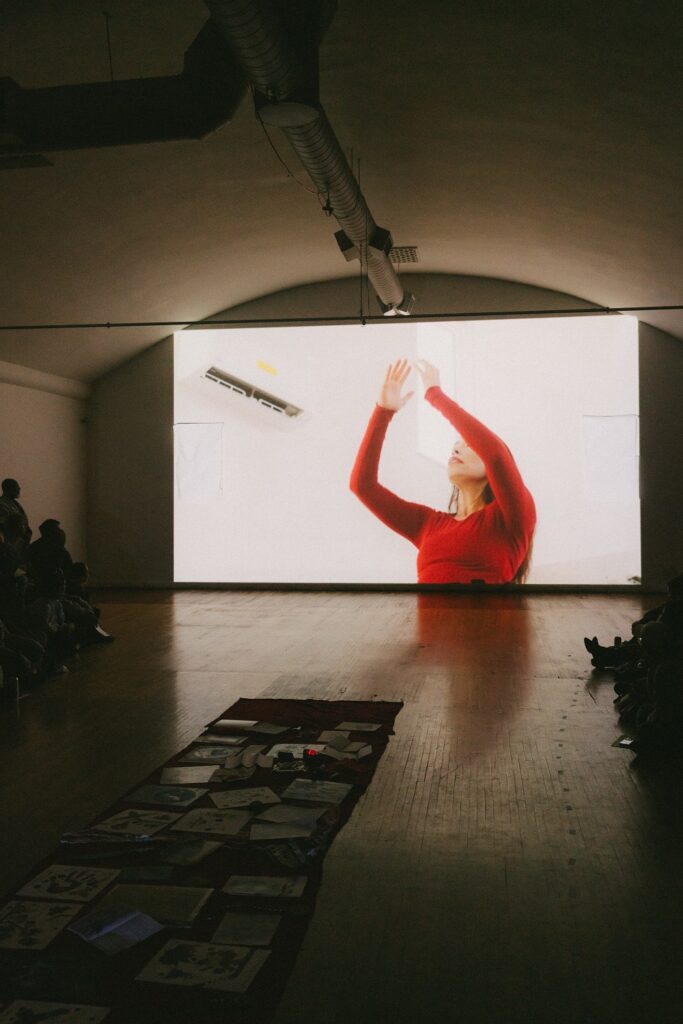
Tria Blu Wakpa in “Ocean Dreams” – Dancing Through Prison Walls – Suchi Branfman – Photo by Shandra Fleming.
Ocean Dreams
Branfman introduced a Dancing Through Prison Walls project titled Ocean Dreams/Mni Owanca Tanka Woihanbla, presented on Monday night, March 3rd, as a film in two parts with a live performance choreographed and directed by Branfman, danced by Tria Blu Wakpa and narrated by Ernst Fenelon, Jr.. The film showed the process of choreographing George Blue Bird’s dance, which he wrote from inside the South Dakota State Penitentiary.
Their collaboration came as part of a pandemic adjustment; Branfman and collaborators, whose work is grounded in choreographic residencies inside prisons, were not allowed inside at the height of Covid-19, so incarcerated movers and dancers began writing dances and sending them out to the Dancing Through Prison Walls community. Branfman and her collaborators would then build movement from the written prompts. Blue Bird, a Lakota elder who has been incarcerated in South Dakota for over 40 years, asked that his dance be performed by his longtime collaborator Blu Wakpa, as close to the ocean as possible.
“He’s been dreaming of going to the Pacific Ocean, which we’re understanding now is a long tradition of Lakota warriors going to be resuscitated and rejuvenated at the Pacific Ocean,” Branfman explained.
Branfman and Blu Wakpa conversed with Blue Bird whenever possible, eventually traveling to South Dakota to show him the dance during a powwow inside the prison. The film, documented and edited by Tom Tsai with music by Leta Wise Spirit, follows their process creating the dance, their phone calls with Blue Bird, their visit South Dakota to share the dance, and the trip they took to perform the dance at Pine Ridge: the land where Blue Bird grew up. This month, they will also take the dance to the ocean itself, dancing the movement and bringing Blue Bird’s art to the Wishtoyo Chumash Village on the Southern California coast.
AREITO
Tavarez’s work AREITO weaves together the Lakota myth of The Old Woman in a Cave and the story of the historical figure Anacaona. She and her collaborators — dramaturg Ajani Brannum and performers Isis Avalos, Jessica Emmanuel, Chohi Kim, Jahliely Salcedo, and Himerria Wortham — have been exploring themes of creation and destruction, and the early colonization of the island of Quisqueya, where her parents are from.
“It’s really a way of looking at the tenacity, the resilience of Afro-Indigenous women,” she told me. “The folks that are in the work really have their own inquiries into this kind of landscape, figuring out how Western hegemonic systems influence how they think, or their concepts of aesthetics or culture, and really pushing back against that.”
Her discoveries in making this work have been based largely in interpreting the stories, consulting elders, culling what she can from what Spanish colonizers wrote about her culture. She and Brannum have grappled with language and artistic license to find the truth in these stories and the ways they have been preserved for generations.
Survival as resistance
In discussing the two works and their uncanny connections, we began with the idea of stories surviving oppression, slavery, incarceration, and colonization — the strength with which these artists hold onto their narratives through the oral tradition.
“George himself was put in an Indian boarding school to take away his language, to take away his culture, to move him away from everything that he is: his stories, his culture, his language, which he has now reclaimed, which he speaks and teaches to other folks inside,” Branfman shared. “
“And you see that none of that is accidental, — that it is absolutely a blueprint that was set and was then repeated throughout the Americas,” Tavarez added. “In modern terms, where people are incarcerated or where languages are taken away, it’s almost like a playbook of how you can erode or corrode the spirit of a human.”
Branfman nodded. “It’s a massive amount of tenacity and resistance to insist on claiming and reclaiming…these stories and histories and legacies, what resilience and what intense commitment, power and force carries these stories and humans forward.”
Tavarez named one method of survival as “repeat practices of transmission, which sometimes are covert and sometimes are overt,” a theme that came up several times in our conversation about these two works. Branfman was reminded of her visits to Blue Bird in South Dakota, particularly to attend powwows inside the prison.
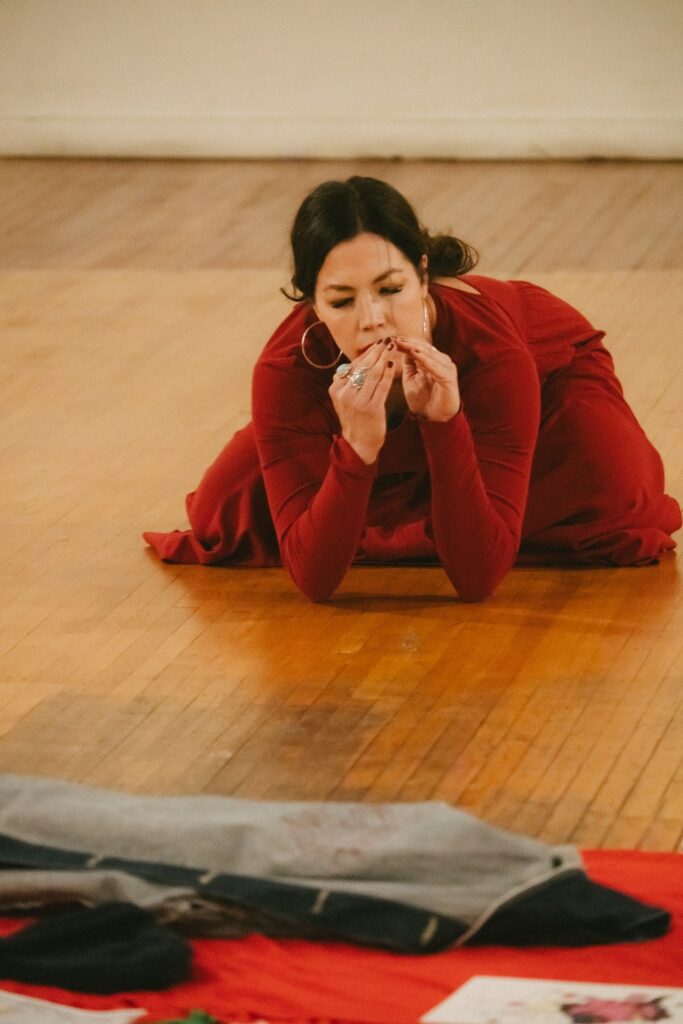
Tria Blu Wakpa in “Ocean Dreams” – Dancing Through Prison Walls – Suchi Branfman – Photo by Shandra Fleming.
“Of course, there’s no difference in the powwow between dancing, music, song culture, all of it. There’s no distinction or separation. They’re all deeply, powerfully, connected. The attempted removal of all of this has been part of the colonization of native folks, to take it all away — and it is incredibly powerful to see it within the context of caging,” Branfman said. “The resistance still happens through these powwows.”
In holding onto these intertwined practices, the artists resist and continue to share and participate in community. The parallels between colonization and incarceration are not coincidental — and in placing these works next to each other, it becomes evident how far back they are intertwined.
“The parallels and the realities of slavery and incarceration are just so deeply connected…and I think that’s part of this work too. We know it here, and we also know it internationally,” Branfman said. “And that’s something George talks a lot about in terms of native lands being taken; he’s always talking about Gaza.”
“I was thinking about how we’re talking about resistance persisting into the present moment as a consequence of necessity,” Tavarez responded. “There’s a gold mining company, Barrick Gold, in the Dominican Republic, and it’s going to be there until 2041, just stripping the land. It started in 1492 and it’s still happening — it’s this extractive relationship.”
In coming together
Both Branfman and Tavarez’s projects work to amplify voices of those oppressed — and in doing so, they have experienced incomparable connection through community.
“Our commitment is to amplifying these stories in whatever spaces we can. We do that in performance spaces but also in community spaces,” Branfman shared. Dancing Through Prison Walls is currently working on a project at Homeboy in downtown L.A. and is in the midst of a 10-year residency at a prison in Norco, where they dance every Monday night.
“Dancing together in community inside the prison gym is just the best, most generative, most loving, most powerful, resistant thing. You know, if we are working towards creating a new world where we live in equity, where we are caring for each other, this is our way of doing that right now,” Branfman shared.
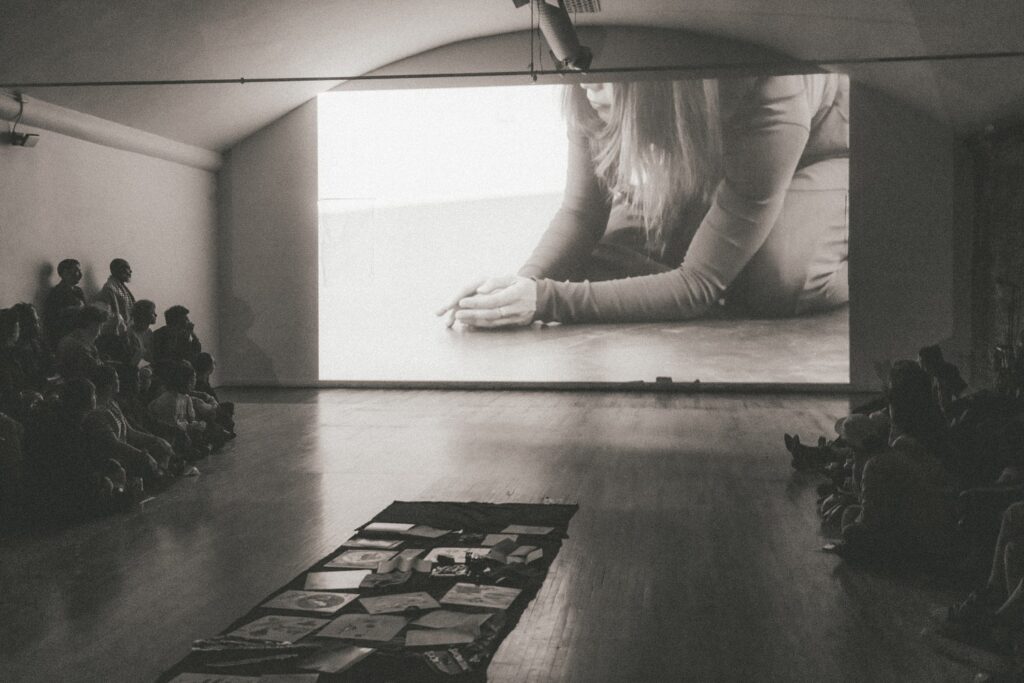
Tria Blu Wakpa in “Ocean Dreams” – Dancing Through Prison Walls – Suchi Branfman – Photo by Shandra Fleming.
“Yes, the work can feel heavy or dark,” Tavarez agreed. “The themes are weighty… and then, you know, at the end of the day, you’re creating, you’re making something: it feels very meaningful in community… the connections and the exchanges and the conversations feel fruitful.”
Her research for AREITO has brought her to Puerto Rico to see the Taíno caves, and into conversation with Dallas Nelson, a citizen of the Oglala Lakota Nation who works with organizations dedicated to amplifying Native culture.
Tavarez has found rich meaning in their exchanges as the work morphs and weaves. Nelson, who was born and raised on the Pine Ridge Reservation where Blue Bird grew up, has invited the cast of AREITO to visit and share the work at Oglala Lakota College, which serves Pine Ridge.
“It feels like the work is this big river,” Branfman responded. “Sometimes it narrows down to a stream and it’s quiet. Sometimes it’s tumultuous, and sometimes there’s somebody on the shore that we need to stop and hang out [with] or bring them in…this idea of continually moving, but not being alone in the movement.”
In watching the work-in-progress showing on Monday night, I kept remembering Branfman’s account of showing Blue Bird the dance for the first time.
“I looked over at George…and he was looking down at the ground,” she explained. “He could see the dance out of the corner of his eyes, and he did watch it. His way of honoring dancers and honoring dance is not by looking straight on at people head on, it’s by looking at people’s feet, by looking in this sort of deep reverence. It was so beautiful because his responses were not the ones that I thought I was after, but they were so much what we were after.”
Blue Bird left a message that played over the second half of the film on Monday night. He told us about his daily routines, his dream to have his dance danced at the ocean, about how his supplies and artwork had been illegally stolen from him in a cell sweep.
“It was really pure chance, part of the work-in-progress process…beautiful to listen to his words juxtaposed with that second film, because it was footage from Pine Ridge, and he was talking about his land,” Branfman told me afterward.
In the studio that night, the team had taped white paper over the back windows so as not to obstruct the projection of the film on the wall. But as Blue Bird’s voice played over the film, and he described the view from the window of his new cell, a corner came unstuck and revealed a window behind it. Tavarez, Branfman and I agreed it couldn’t be coincidental.
He also listened in via phone to be in community with us, the audience, as Fenelon read Blue Bird’s writings, a declaration about the strength and passion of Lakota dancers. Fenelon and Blu Wakpa brought their fists to their chests, pounding heartbeats in a resounding solidarity.
In the second half of the evening, Tavarez’s work came up against a technical difficulty, but what resulted was a profound full-body listening between the cast members, their breath aligning and guiding them in a practice that felt so sacred.
“When you have a known container, which is your orienting device… and then that goes away. What do you do? You hold on to each other,” Tavarez laughed.
Together, they built sculpture to hold the narratives and then released it into movements. Emmanuel handled a swirling mass of gold thread with tender authority; Kim released sound so deeply formed I could feel it in my own gut; Wortham spiraled and spoke and whirled as Guabancex, the Taíno hurricane deity in a rage borne from all the carrying. And at the end, they took intentional time to care for each other in ritual.
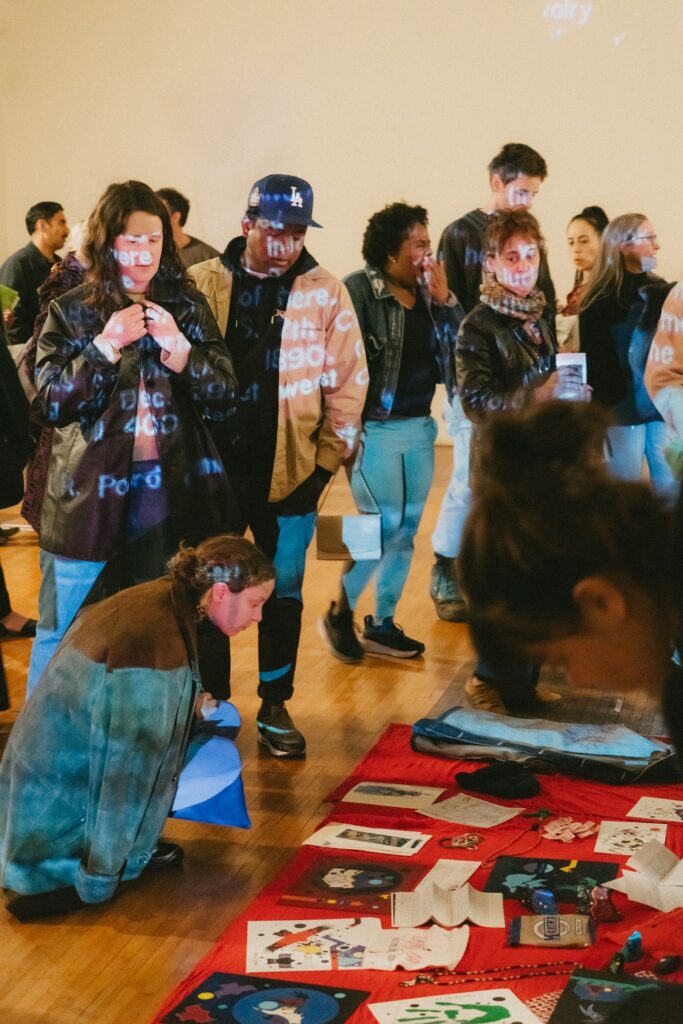
WIP LA 015 audience during “Ocean Dream” – Dancing Through Prison Walls – Suchi Branfman – Photo by Shandra Fleming.
Transmission
After the work, we spoke about balancing the movement itself with the truth of these stories — how we transmit narrative through our bodies.
“It’s morphing that into dance that isn’t necessarily in the vocabulary of that tradition,” Tavarez said. “It’s saying, ‘there is another way to do this that’s in the energy of the thing, or the texture of the thing, right?’ And it has to come from the bodies of people that understand the energy and texture of the thing but isn’t necessarily trying to replicate traditional dances.”
Branfman recalled the powwow, where they couldn’t show film or even bring a sound score to share the dance, but Blue Bird supplied a heartbeat rhythm and the drummers dove in, driving Blu Wakpa’s movements. Tavarez and I recognized the heartbeat from the introduction of Blu Wakpa’s performance at WIP LA — the music as part of the dance, the dance as part of the music.
“Going back thousands of years, our first impulse was to just come together,” Tavarez said. “And the dance was speaking to the music, and the music was speaking to storytelling, and it was all one thing.”
To learn more about WIP LA, please visit their website.
To learn more about G-Son Studios, please visit their website.
Written by Celine Kiner for LA Dance Chronicle.
Featured image: AREITO by Rosanna Tavarez – Photo © Cheryl Mann.

